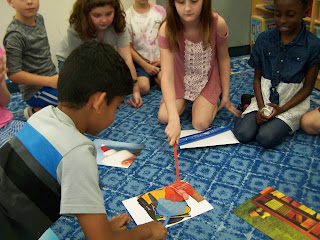In the Spanish language, all nouns have gender; some are
masculine and others feminine. Every
noun has a specific, definite article that indicates the gender of the word. The
definite article means “the” in English while in Spanish there are four forms,
depending on whether the noun is masculine, feminine, singular or plural. La (singular) and las (plural) are feminine articles and el (singular) and los
(plural) are masculine articles. Often, masculine nouns end with –o and most of
the time feminine words end with –a. But, because many nouns end in letters
other than –o or –a, it’s always good to learn and memorize the definite
article when learning a new noun. So, to put these grammar concepts to
practice, the third graders have been learning the vocabulary for some
classroom objects and its definite article. We first began with focusing on the
singular forms el and la. Here, give it a try:
1.
The backpack -
______ mochila
2.
The bookcase - ______ librero
3.
The calculator - ______ calculdora
4.
The calendar - ______ calendario
5.
The whiteboard - ______ pizzarón blanco
6.
The computer - ______ computadora
After introducing the vocabulary, the students were
challenged to a fun game of los matamoscas
(the fly swatter) game. In this game, the flashcards were placed on the floor
and the object was for the students to match the oral command with it
corresponding picture by gently swatting the card. Both the small and the large
swatters were used.
Another game we played to help reinforce the new
vocabulary and its definite article was Pulgar
Arriba (Thumbs-Up). To start this game, students are
selected and invited to the front of the classroom. The students seated at the
tables are encouraged to place their heads down with eyes shut, extend their
arm and put their pulgar arriba. The
chosen students are given a flashcard and then circulate the area, secretly
pressing one thumb each and then returning to the front of the room. On cue,
the students raise their heads and each takes a turn at guessing who pressed
their thumb. But, instead of using the student’s name, she or he states the
item and its definite article on the flashcard that the individual is holding
up. What fun! Next, following these auditory fun activities, we will complete
worksheets that include reading and writing the newly learned words and their
definite articles. Stay tuned!






No comments:
Post a Comment